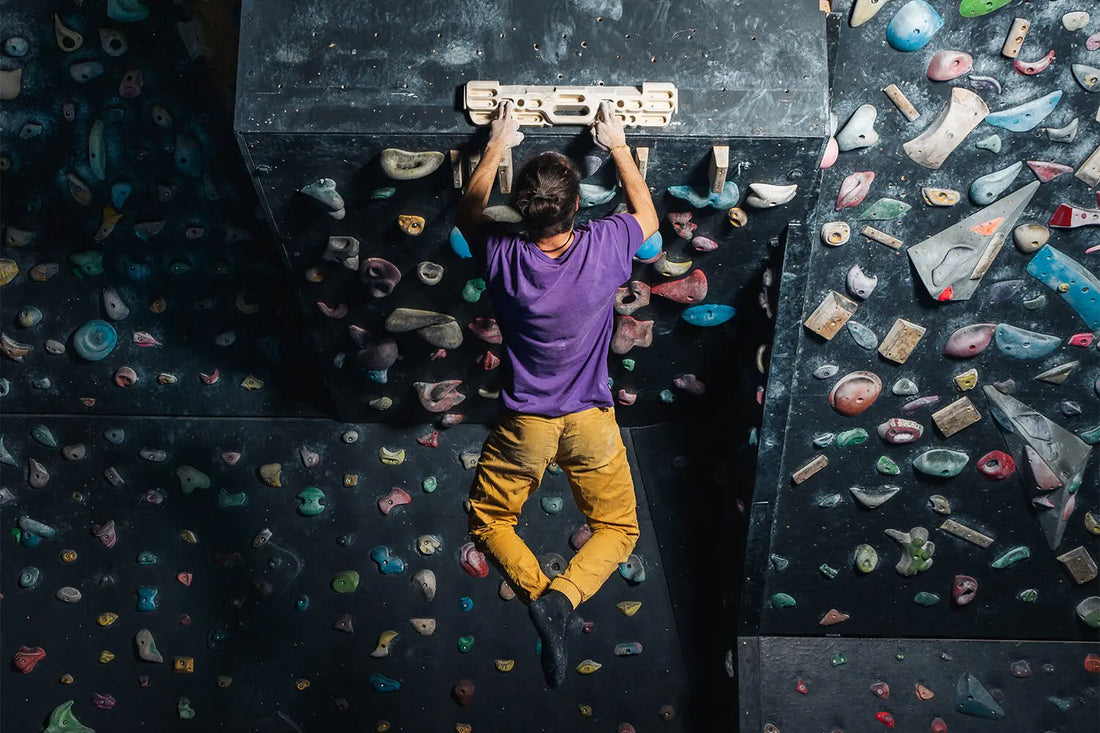
Mastering the Hangboard: Essential Tips for Climbing Strength
Hangboard training is one of the most effective ways to build the finger strength and grip endurance that are crucial for climbing success. Whether you're a beginner looking to improve your climbing performance or an experienced climber aiming to break through a plateau, mastering the hangboard can make a significant difference. In this blog, we’ll cover essential tips to help you get the most out of your hangboard sessions, avoid injury, and see real progress in your climbing strength.
Why Hangboard Training Matters
Climbing places tremendous stress on your fingers and forearms. While climbing itself naturally develops these muscles, hangboarding allows you to target them in a controlled and specific manner. By consistently working on the hangboard, you can:
1. Increase Finger Strength: Hangboarding isolates finger muscles, allowing for targeted strength gains that directly translate to better climbing performance.
2. Improve Grip Endurance: Longer hang times on the board build the endurance needed for sustained grip strength on challenging routes.
3. Enhance Mental Toughness: Hangboarding requires focus and discipline, which can boost your mental resilience, a key component of successful climbing.
Getting Started with Hangboard Training
If you’re new to hangboarding, it’s important to start slowly and focus on form to avoid injury. Here are some foundational tips:
1. Warm Up Properly: Before you even touch the hangboard, ensure you’re thoroughly warmed up. This should include general body movements like jumping jacks or jogging, as well as specific climbing-related exercises such as finger rolls, wrist rotations, and light stretching. A good warm-up increases blood flow to your muscles and reduces the risk of injury.
2. Start with a Solid Base: If you’re relatively new to climbing or haven’t done much finger-specific training, build a solid base by focusing on easier grips, such as open-hand holds on larger edges. Starting with these less intense grips helps strengthen your tendons and muscles gradually.
3. Focus on Form: Proper form is crucial in hangboard training. Keep your shoulders engaged (no shrugging or sagging), maintain a slight bend in your elbows, and avoid twisting your body. Your hands should be in a neutral position, not over-rotated or under-rotated. This helps distribute the load evenly and prevents strain on your joints.
4. Gradual Progression: It’s tempting to push yourself hard, but progression should be gradual. Start with shorter hangs (5-7 seconds) and increase the duration as your strength improves. Similarly, begin with longer rest periods between sets (2-3 minutes) and shorten them over time. Incrementally increasing difficulty ensures steady progress without overloading your muscles and tendons.
5. Incorporate a Variety of Grips: To develop well-rounded strength, use a variety of grip positions, including open hand, half-crimp, full-crimp, and pinch grips. Each grip targets different muscles and tendons in your fingers and forearms, helping to create balanced strength that’s applicable to diverse climbing scenarios.
6. Rest and Recovery: Hangboarding is intense, so adequate rest is essential. Allow at least 48 hours between hangboard sessions to give your muscles and tendons time to recover and grow stronger. Additionally, listen to your body—if you feel pain (not to be confused with the discomfort of hard work), take a break and reassess your training routine.
Advanced Hangboard Techniques
1. Once you’ve built a solid foundation, you can start incorporating more advanced techniques into your hangboard training:
2. Max Hangs: Max hangs involve hanging from the smallest edge you can hold onto with good form for about 7-10 seconds. This technique is great for increasing absolute finger strength. Be sure to rest adequately between sets to maintain high intensity during each hang.
3. Repeaters: Repeaters are a popular method for improving both strength and endurance. Perform a series of shorter hangs (e.g., 7 seconds on, 3 seconds off) repeated multiple times in a row before taking a longer rest. This method builds the ability to hold onto difficult grips for extended periods.
4. Weighted Hangs: Once you’re comfortable with max hangs, you can add weight to your body to increase the intensity. Start with a small amount of additional weight and increase it gradually as your strength improves. Weighted hangs are excellent for breaking through plateaus and building serious finger strength.
5. One-Handed Hangs: For an even greater challenge, try one-handed hangs. These require significant strength and should only be attempted once you have mastered two-handed hangs on various grips. Use a fingerboard with a variety of edge sizes to match your current strength level.
Avoiding Common Pitfalls
To get the most out of your hangboard training and prevent injuries, keep these tips in mind:
- Don’t Rush Progress: Finger tendons and ligaments take longer to adapt than muscles. Pushing too hard too fast can lead to injuries like tendonitis or pulley tears. Patience and consistency are key to safe and effective hangboard training.
- Mix It Up: Avoid doing the same routine every time. Vary your grips, hang times, and rest intervals to keep your muscles challenged and prevent overuse injuries.
3. Incorporate Active Rest: On rest days, engage in activities that promote recovery, such as light stretching, yoga, or gentle climbing. Active rest helps maintain flexibility and blood flow to your muscles without adding strain.
Conclusion
Mastering the hangboard is a powerful way to boost your climbing strength, but it requires careful attention to form, progression, and recovery. By starting slowly, incorporating a variety of grips and techniques, and listening to your body, you can safely build the finger strength and endurance needed to excel in climbing. As with any training program, consistency is key—stick with it, and you’ll see significant improvements in your climbing performance. Happy hangboarding!
